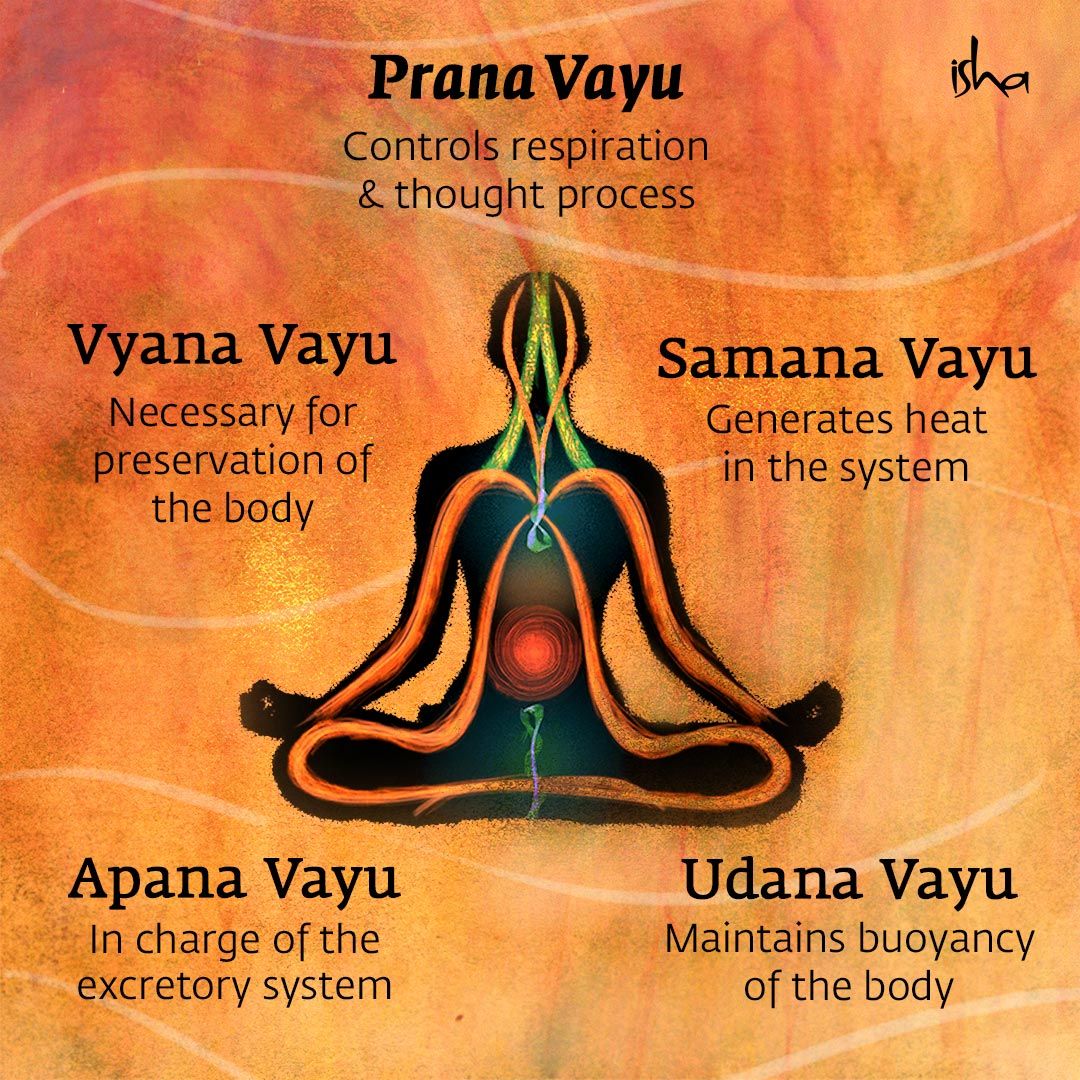What are the five Pranas Vayus (Life Force Energies) of the human body that facilitate physiological & psychological balance?

Updated: July 06, 2023
In the Vedic system, the five Vayus, or vital energies (also known as Pranas), are responsible for various functions within the human body. These Vayus are essential for maintaining a healthy balance and flow of energy.
Each Vayu is responsible for specific physiological and psychological functions.
1. Prana Vayu:
Prana Vayu is one of the five main pranas, or vital energies, that are believed to be present in the human body. It is said to be responsible for the upward movement of energy, including inhalation, breathing, and oxygen intake. In this article, we will explore the concept of Prana Vayu in more detail, including its characteristics, functions, and benefits.
Characteristics of Prana Vayu
Prana Vayu is a subtle energy associated with the heart and lungs. It is considered a vital force that animates the physical body and is essential in maintaining physical, mental, and emotional health.
According to Ayurveda, the ancient Indian system of medicine, Prana Vayu is also responsible for the following characteristics:
- Vitality and energy
- Alertness and clarity of mind
- Inspiration and motivation
- Creativity and self-expression
Functions of Prana Vayu
Prana Vayu is responsible for the following physiological functions in the body:
- Inhalation: Prana Vayu is responsible for the upward movement of energy that occurs during inhalation. It helps to bring in fresh oxygen, which is necessary for the proper functioning of the body.
- Breathing: Prana Vayu is also responsible for the overall breathing process, including the expansion and contraction of the lungs.
- Circulation: Prana Vayu helps to circulate energy throughout the body, including the blood and other bodily fluids.
- Heart function: Prana Vayu is closely associated with the heart and is responsible for maintaining its proper function.
- Mental clarity: Prana Vayu is also responsible for mental clarity and focus. It helps to sharpen the mind and enhance cognitive function.
Benefits of Prana Vayu
Cultivating Prana Vayu can have several benefits for overall health and well-being. Some of the potential benefits of Prana Vayu include:
- Increased energy and vitality
- Improved mental clarity and focus
- Enhanced creativity and self-expression
- Improved heart function and circulation
- More excellent overall health and well-being
Practices to Cultivate Prana Vayu
Several practices can help to cultivate and balance Prana Vayu. Some of these practices include:
- Asana (Yoga Poses): Poses that open up the chest and stimulate the heart area can help balance Prana Vayu. These include poses such as Bhujangasana (Cobra Pose), Ustrasana (Camel Pose), and Setu Bandha Sarvangasana (Bridge Pose).
- Pranayama (Breathing Exercises): Certain breathing exercises focusing on inhalation can help stimulate Prana Vayu. These include practices like Nadi Shodhana Pranayama (Alternate Nostril Breathing), which balances the entire pranic system, and Dirgha Pranayama (Three-Part Breath), which encourages complete breaths.
- Meditation: Practicing meditation focusing on the inhalation, or the feeling of energy being drawn into the body, can help cultivate Prana Vayu. Many meditation practices exist, but sitting quietly and focusing on the breath can be an excellent place to start.
- Diet: Since Prana Vayu is related to the intake and absorption of nutrients, a balanced diet rich in prana (life force), such as fresh fruits, vegetables, and whole grains, can support its balance. Avoiding overeating and eating mindfully can also be beneficial.
- Lifestyle Practices: Spending time in nature, especially where the air is fresh and clean, can help balance Prana Vayu, as can ensuring good indoor air quality. Practices that promote relaxation and reduce stress, such as getting enough sleep, can also support the balance of Prana Vayu.

2. Apana Vayu:
It is responsible for the downward and outward movement of energy, including elimination, childbirth, and sexual functions. In this article, we will explore the concept of Apāna Vāyu in more detail, including its characteristics, functions, and benefits.
Characteristics of Apāna Vayu
Apāna Vāyu is a subtle energy associated with the body's lower half. It is considered a vital force that animates the physical body and is essential in maintaining physical, mental, and emotional health.
According to Ayurveda, Apāna Vāyu is also responsible for the following characteristics:
- Elimination: Apāna Vāyu is responsible for energy's downward and outward movement during elimination. It helps to remove waste and toxins from the body.
- Childbirth: Apāna Vāyu is also responsible for the downward and outward movement of energy that occurs during childbirth. It helps to facilitate the delivery of the baby.
- Sexual functions: Apāna Vāyu is closely associated with sexual functions in both men and women.
Functions of Apāna Vāyu
Apāna Vāyu is responsible for the following physiological functions in the body:
- Elimination: Apāna Vāyu is responsible for energy's downward and outward movement during elimination. It helps to remove waste and toxins from the body.
- Childbirth: Apāna Vāyu is also responsible for the downward and outward movement of energy that occurs during childbirth. It helps to facilitate the delivery of the baby.
- Sexual functions: Apāna Vāyu is closely associated with sexual functions in both men and women. It helps to regulate sexual desire, arousal, and orgasm.
Benefits of Apāna Vāyu
Cultivating Apāna Vāyu can have many benefits for overall health and well-being. Some of the potential benefits of Apāna Vāyu include:
- Improved digestion: Apāna Vāyu helps to regulate digestion and elimination, which can help to improve overall digestive health.
- Better sexual health: Apāna Vāyu is closely associated with sexual functions, and cultivating this energy can help to improve sexual health and function.
- Reduced stress and anxiety: Balancing Apāna Vāyu can help reduce stress and anxiety and promote feelings of relaxation and calm.
- Improved overall health and well-being: Cultivating Apāna Vāyu can help to support overall health and well-being by promoting balance and harmony in the body.
Practices to Cultivate Apana Vayu
Several practices can help to cultivate and balance Apana Vayu. Some of these practices include:
- Asana (Yoga Poses): Poses that stimulate the pelvic and lower abdominal regions can help balance Apana Vayu. These include poses like Malasana (Garland Pose), Pavanamuktasana (Wind-Relieving Pose), and Baddha Konasana (Bound Angle Pose).
- Pranayama (Breathing Exercises): Certain breathing exercises can stimulate Apana Vayu. This includes practices like Mula Bandha (Root Lock), where one contracts the muscles at the base of the spine. Also, Rechaka Pranayama, or prolonged exhalation, encourages the downward flow of Apana Vayu.
- Meditation: Focusing your attention on the area between the navel and the base of the spine, which is the region governed by Apana Vayu, during meditation can help to balance this energy.
- Diet: Since Apana Vayu is connected with elimination, a fiber-rich diet helps maintain regular bowel movements and supports its balance. Hydration is also essential.
- Lifestyle Practices: Regular exercise, mainly walking, can stimulate Apana Vayu. Establishing regular elimination habits can also help balance this energy.
- Releasing Negative Emotions: Since Apana Vayu is associated with letting go and eliminating on all levels, practices that promote emotional release, such as journaling, counseling, and certain types of meditative practices, can be beneficial.
Learn about Yogic Chakras.
3. Samana Vayu:
It is responsible for the digestive and metabolic functions of the body, and it plays a vital role in maintaining overall health and well-being.
Characteristics of Samana Vayu
Samana Vayu is characterized as a subtle energy associated with the digestive system. It is considered a vital force that animates the physical body and is essential in maintaining physical, mental, and emotional health.
According to Ayurveda, Samana Vayu is also responsible for the following characteristics:
- Digestion: Samana Vayu is responsible for the digestive and metabolic functions of the body. It helps break down food, absorb nutrients, and eliminate waste products.
- Energy balance: Samana Vayu helps balance the body's energy, including the other pranas. It regulates energy flow and maintains overall balance and harmony.
- Mental clarity: Samana Vayu is also responsible for mental clarity and focus. It helps to sharpen the mind and enhance cognitive function.
Functions of Samana Vayu
Samana Vayu is responsible for the following physiological functions in the body:
- Digestion: Samana Vayu is responsible for the digestive and metabolic functions of the body. It helps break down food, absorb nutrients, and eliminate waste products.
- Energy balance: Samana Vayu helps balance the body's energy, including the other pranas. It regulates energy flow and maintains overall balance and harmony.
- Mental clarity: Samana Vayu is also responsible for mental clarity and focus. It helps to sharpen the mind and enhance cognitive function.
Benefits of Samana Vayu
Cultivating Samana Vayu can have several benefits for overall health and well-being. Some of the potential benefits of Samana Vayu include:
- Improved digestion: Samana Vayu is responsible for the digestive and metabolic functions of the body, and cultivating this energy can help to improve overall digestive health.
- Better energy balance: Samana Vayu helps balance the body's energy, including the other pranas, which can help promote overall balance and harmony.
- Enhanced mental clarity: Balancing Samana Vayu can help improve mental clarity and focus and enhance cognitive function.
- Improved overall health and well-being: Cultivating Samana Vayu can help to support overall health and well-being by promoting balance and harmony in the body.
Practices to Cultivate Samana Vayu
Several practices can help to cultivate and balance Samana Vayu. Some of these practices include:
- Asana (Yoga Poses): Poses that focus on the abdominal region can help to stimulate and balance Samana Vayu. This includes poses such as Naukasana (Boat Pose), Pavanamuktasana (Wind Relieving Pose), and twists like Ardha Matsyendrasana (Half Lord of the Fishes Pose) and Marichyasana (Sage Marichi's Pose).
- Pranayama (Breathing Exercises): Certain breathing exercises that involve the belly can help stimulate Samana Vayu. These include practices like Agnisar Kriya, which involves the rapid contraction and relaxation of the abdominal muscles, and Nadi Shodhana (Alternate Nostril Breathing), which balances the entire pranic system.
- Meditation: Focusing your attention on the area around the solar plexus, which is governed by Samana Vayu, can help balance this energy.
- Diet: Since Samana Vayu is directly related to digestion, a balanced diet is critical in maintaining its balance. Eating wholesome, freshly cooked food at regular intervals supports digestive health. Avoiding overeating and not eating when stressed or distracted also helps.
- Lifestyle Practices: Regular exercise and a consistent daily routine are essential for balancing Samana Vayu. This includes regular meal times, adequate rest, and managing stress.
- Apana and Prana Vayu Practices: In yogic understanding, Samana Vayu serves as a balancing force between Prana Vayu, the incoming life force, and Apana Vayu, the outgoing life force. Therefore, practices that cultivate and balance these two forces can indirectly help to balance Samana Vayu.
4. Udana Vayu:
It is responsible for the upward movement of energy and is vital in maintaining physical, mental, and emotional health.
Characteristics of Udana Vayu
Udana Vayu is a subtle energy associated with the head and chest regions of the body. It is considered a vital force that animates the physical body and plays an essential role in maintaining physical, mental, and emotional health.
According to Ayurveda, Udana Vayu is also responsible for the following characteristics:
- Speech and expression: Udana Vayu is closely associated with the ability to speak and express oneself effectively. It helps to regulate the muscles involved in speech and communication.
- Strength and stability: Udana Vayu is also responsible for physical strength and stability, and it helps to maintain proper posture and alignment.
- Vitality and enthusiasm: Udana Vayu is also associated with vitality and enthusiasm, and it helps to promote feelings of joy and happiness.
Functions of Udana Vayu
Udana Vayu is responsible for the following physiological functions in the body:
- Respiration: Udana Vayu is responsible for the upward movement of energy during respiration. It helps move air into and out of the lungs and plays a vital role in maintaining proper breathing.
- Speech and communication: Udana Vayu helps to regulate the muscles involved in speech and communication, allowing for practical expression and communication.
- Swallowing: Udana Vayu is also responsible for swallowing. It helps move food and liquid from the mouth to the stomach.
- Mental clarity: Udana Vayu is also responsible for mental clarity and focus. It helps to sharpen the mind and enhance cognitive function.
Benefits of Udana Vayu
Cultivating Udana Vayu can have several benefits for overall health and well-being. Some of the potential benefits of Udana Vayu include:
- Improved speech and communication: Udana Vayu helps to regulate the muscles involved in speech and communication, allowing for practical expression and communication.
- Increased physical strength and stability: Udana Vayu is also responsible for physical strength and stability; cultivating this energy can help improve posture and alignment.
- Enhanced mental clarity and focus: Balancing Udana Vayu can help improve mental clarity and focus and enhance cognitive function.
- More excellent overall health and well-being: Cultivating Udana Vayu can help to support overall health and well-being by promoting balance and harmony in the body.
Practices to Cultivate Udana Vayu
Several practices can help to cultivate and balance Udana Vayu. Some of these practices include:
- Asana (Yoga Poses): Poses that open and stimulate the throat and neck can help balance Udana Vayu. These include poses such as Sarvangasana (Shoulder Stand), Halasana (Plow Pose), and Matsyasana (Fish Pose). Forward bends can also help regulate Udana Vayu by calming the mind and encouraging introspection.
- Pranayama (Breathing Exercises): Ujjayi Pranayama (Victorious Breath or Ocean Breath), which emphasizes a slight constriction of the throat, is especially beneficial for balancing Udana Vayu. Similarly, Bhramari Pranayama (Bee Breath) helps soothing and calming the mind, balancing the Udana Vayu.
- Meditation and Mantra Chanting: Since Udana Vayu is related to speech and expression, practices that involve the voice can be beneficial. Chanting mantras, singing, or practicing mindfulness meditation focusing on the throat area can help balance Udana Vayu.
- Diet and Lifestyle: Consuming food and drinks good for the throat and voice, such as warm herbal teas with honey, can be beneficial. Also, expressing yourself honestly and constructively in your daily life can contribute to the health of Udana Vayu.
- Jalandhara Bandha (Throat Lock): This is a yogic lock technique where the chin is brought down towards the chest while practicing pranayama. It controls the energy flow in the nerves and blood vessels of the neck, which can help balance Udana Vayu.
- Silence and Reflection: Regular periods can also help balance Udana Vayu, giving the sensory organs a chance to rest and recharge. This can also include activities that promote reflection and introspection.
5. Vyana Vayu:
Vyana Vayu, often called the "outward moving air," is associated with circulation and movement throughout the body.
Characteristics of Vyana Vayu
Vyana Vayu is a diffusive or circulating force that governs the entire body, pervading all other vayus and cells. It can be understood as the energy that coordinates and integrates the activities of the other vayus, ensuring the body's functioning as a unified whole.
Vyana Vayu is associated with the heart and the circulatory system. It is responsible for the circulation of nutrients and life force (prana), as well as the movement of limbs and overall motor coordination. It plays a significant role in distributing energy derived from food and breath throughout the body.
Functions of Vyana Vayu
As the circulatory vayu, Vyana governs blood flow from the heart to all body parts and back. It ensures that oxygen, nutrients, and prana are appropriately distributed to every cell. Vyana Vayu also governs the nervous system's communication, facilitating the movement of impulses between the brain and the body's parts.
Vyana Vayu helps maintain the body's homeostasis, ensuring a balance between the internal and external environments. It aids in regulating body temperature, sweat secretion, and other functions related to maintaining this balance.
Another essential function of Vyana Vayu is related to movement and coordination. It enables the synchronized functioning of different muscles and joints, allowing us to perform complex physical tasks. When Vyana Vayu functions properly, the body can move with grace, agility, and coordination.
Benefits of Vyana Vayu
- Improved Circulation: Since Vyana Vayu governs the circulatory system, its optimal functioning can improve blood circulation, ensuring all body parts receive nutrients and oxygen.
- Enhanced Motor Coordination: Vyana Vayu is associated with movement coordination. When balanced, we can expect better balance, motor skills, and grace in physical activities.
- Better Energy Distribution: Vyana Vayu contributes to distributing the energy derived from food and breath throughout the body. Enhancing this Vayu can lead to improved energy levels and vitality.
- Improved Bodily Homeostasis: Vyana Vayu assists in maintaining equilibrium within the body. This includes maintaining body temperature and regulating other physiological processes necessary for homeostasis.
- Enhanced Nervous System Function: As the coordinating and integrating vayu, Vyana Vayu facilitates the flow of impulses between the brain and body parts. This can potentially lead to improved nervous system function, affecting all health aspects.
- Emotional and Mental Balance: Working with Vyana Vayu can promote emotional and mental equilibrium, in addition to the physical benefits. A balanced Vyana Vayu can contribute to a greater sense of interconnectedness, expansiveness, and peace.
Practices to Cultivate Vyana Vayu
Certain yogic practices can help balance and strengthen Vyana Vayu:
- Asana practice: Yoga poses that encourage opening and creating space in the body can be particularly beneficial. Poses like Trikonasana (Triangle Pose), Vrikshasana (Tree Pose), and Tadasana (Mountain Pose) can help cultivate and balance Vyana Vayu.
- Pranayama: Certain breathing exercises are believed to impact Vyana Vayu directly. Anulom Vilom (Alternate Nostril Breathing) and Kapalabhati (Skull Shining Breath) are commonly recommended.
- Meditation: Practicing mindfulness and body-awareness meditation helps in the smoother flow of energy and can support the balancing of Vyana Vayu.
- Diet and lifestyle: In Ayurveda, balanced eating and maintaining a regular daily routine contribute to the health of all bodily systems. A diet rich in fresh fruits, vegetables, and whole grains is recommended.
Conclusion:
Here's a comparative chart:
| English Name | Hindi Name | Location | Function | Direction | Chakra | Element | Expression |
|---|---|---|---|---|---|---|---|
| Prana Vayu | प्राण वायु | Chest and Throat | Governs breath and life force | Inward and upward | Anahata | Air | Vitality, Energy |
| Apana Vayu | अपान वायु | Pelvic region | Elimination of waste and toxins | Downward | Muladhara | Earth | Grounding, Release |
| Samana Vayu | समान वायु | Abdominal region | Assimilation and digestion | Inward and outward | Manipura | Fire | Transformation |
| Udana Vayu | उदान वायु | Head and Throat | Speech, sensory perception | Upward and outward | Vishuddha | Ether | Expression, Voice |
| Vyana Vayu | व्यान वायु | Whole body | Circulation and movement | Outward and all directions | Sahasrara | Ether | Connection, Flow |
Learn about Yogic Chakras.



